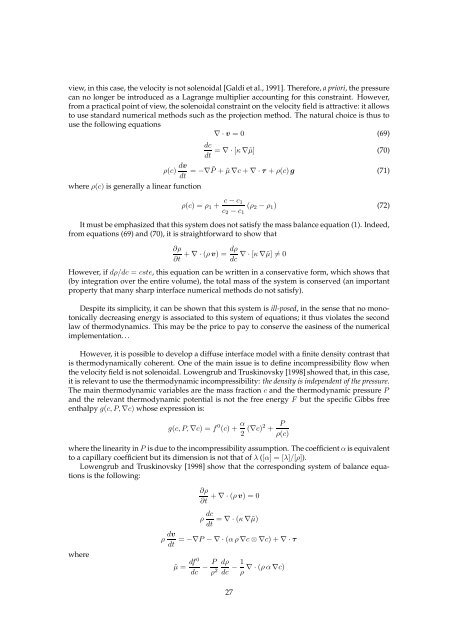Diffuse interface models in fluid mechanics
Diffuse interface models in fluid mechanics
Diffuse interface models in fluid mechanics
Create successful ePaper yourself
Turn your PDF publications into a flip-book with our unique Google optimized e-Paper software.
view, <strong>in</strong> this case, the velocity is not solenoidal [Galdi et al., 1991]. Therefore, a priori, the pressurecan no longer be <strong>in</strong>troduced as a Lagrange multiplier account<strong>in</strong>g for this constra<strong>in</strong>t. However,from a practical po<strong>in</strong>t of view, the solenoidal constra<strong>in</strong>t on the velocity field is attractive: it allowsto use standard numerical methods such as the projection method. The natural choice is thus touse the follow<strong>in</strong>g equations∇ · v = 0 (69)dc= ∇ · [κ ∇˜µ]dt(70)ρ(c) dvdt = −∇ ˜P + ˜µ ∇c + ∇ · τ + ρ(c) g (71)where ρ(c) is generally a l<strong>in</strong>ear functionρ(c) = ρ 1 + c − c 1c 2 − c 1(ρ 2 − ρ 1 ) (72)It must be emphasized that this system does not satisfy the mass balance equation (1). Indeed,from equations (69) and (70), it is straightforward to show that∂ρdρ+ ∇ · (ρ v) = ∇ · [κ ∇˜µ] ≠ 0∂t dcHowever, if dρ/dc = cste, this equation can be written <strong>in</strong> a conservative form, which shows that(by <strong>in</strong>tegration over the entire volume), the total mass of the system is conserved (an importantproperty that many sharp <strong><strong>in</strong>terface</strong> numerical methods do not satisfy).Despite its simplicity, it can be shown that this system is ill-posed, <strong>in</strong> the sense that no monotonicallydecreas<strong>in</strong>g energy is associated to this system of equations; it thus violates the secondlaw of thermodynamics. This may be the price to pay to conserve the eas<strong>in</strong>ess of the numericalimplementation. . .However, it is possible to develop a diffuse <strong><strong>in</strong>terface</strong> model with a f<strong>in</strong>ite density contrast thatis thermodynamically coherent. One of the ma<strong>in</strong> issue is to def<strong>in</strong>e <strong>in</strong>compressibility flow whenthe velocity field is not solenoidal. Lowengrub and Trusk<strong>in</strong>ovsky [1998] showed that, <strong>in</strong> this case,it is relevant to use the thermodynamic <strong>in</strong>compressibility: the density is <strong>in</strong>dependent of the pressure.The ma<strong>in</strong> thermodynamic variables are the mass fraction c and the thermodynamic pressure Pand the relevant thermodynamic potential is not the free energy F but the specific Gibbs freeenthalpy g(c, P, ∇c) whose expression is:g(c, P, ∇c) = f 0 (c) + α 2 (∇c)2 +where the l<strong>in</strong>earity <strong>in</strong> P is due to the <strong>in</strong>compressibility assumption. The coefficient α is equivalentto a capillary coefficient but its dimension is not that of λ ([α] = [λ]/[ρ]).Lowengrub and Trusk<strong>in</strong>ovsky [1998] show that the correspond<strong>in</strong>g system of balance equationsis the follow<strong>in</strong>g:Pρ(c)whereρ dvdt∂ρ+ ∇ · (ρ v) = 0∂tρ dc = ∇ · (κ ∇˜µ)dt= −∇P − ∇ · (α ρ ∇c ⊗ ∇c) + ∇ · τ˜µ = df 0dc − P dρρ 2 dc − 1 ∇ · (ρ α ∇c)ρ27











![[Diffusion-Limited Aggregation - A Model for Pattern Formation].](https://img.yumpu.com/52395246/1/190x245/diffusion-limited-aggregation-a-model-for-pattern-formation.jpg?quality=85)




